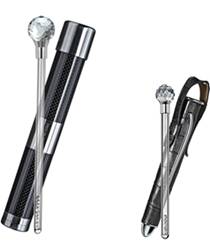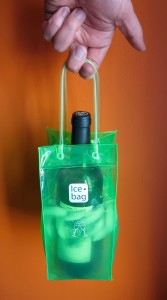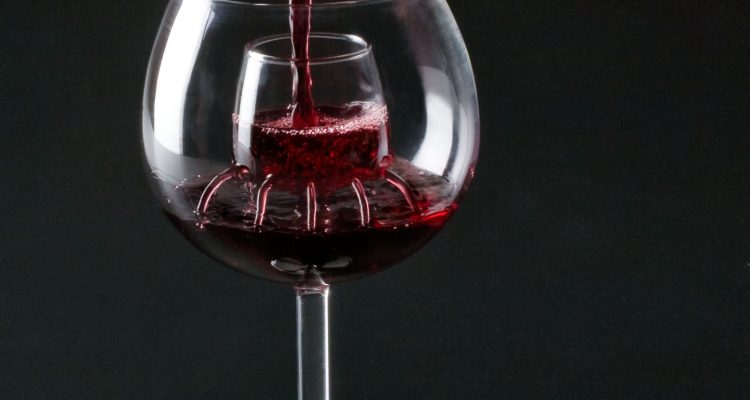It’s that time of year: when shoppers wonder and/or fret about what to get for their favorite oenophiles. Around this time, lots of gadgets ranging from the practical to those that claim to violate the laws of physics cross our desks. Just in time for Black Friday, here are some reviews from the Palate Press editorial board.
Chevalier Collection Legacy Glass
Price: $24
by: David Honig
Nobody could possibly call this glass boring. The outer bowl is medium-sized, rounded, narrowing at the top. An inner glass rises from a stem in the center. The smaller inner glass, holding about two ounces, is squared at the bottom, tapering slightly inward at the top. The key to the glass is the eight small holes around the bottom perimeter of the inner glass. When wine is poured into the inner glass it comes out the small holes into the big bowl.

The idea is that the wine will get aerated by the spray into the lower glass.
I blind-tested the glass against a a Vinturi aerator and no aerator at all. My lovely wife poured two different wines, first a a 2005 Bordeaux, then a 2005 Chianti. Using three identical glasses she poured the wine with no aeration at all, with aeration via Vinturi, and aeration via the Legacy Glass. In both cases I picked out the glass with no aeration. With the Chianti, which had been open already for a couple of hours, I could not tell the difference between the wines aerated with the Legacy Glass and the Vinturi. With the Bordeaux, the Venturi was not quite as full or round as the wine from the Legacy Glass. For aerating purposes I would have to say the Legacy Glass works.
As a wine glass, though, it is not quite the same story. A great wine glass has thin walls and a smooth lip. This glass has thick walls and a thickly beaded rim. Wine does not feel as if it flows smoothly, and the thickness in the mouth is obvious and distracting.
The idea behind the glass is that it is a two-in-one product, aerator and glass. It does an admirable job in only one of those goals, and for that reason cannot be highly recommended, though it might be nice to own one for the entertainment value. It is truly a strange looking glass, sure to be a conversation starter at any meal or wine tasting.
NewAir Wine Cooler by Air & Water
Price: $170
by: Ryan Reichert

The NewAir AW-181E thermoelectric wine cooler is the second wine refrigerator I’ve owned, and was a welcome expansion, allowing additional storage of up to 18 bottles. Assembly was ridiculously easy, requiring only the handle be screwed on to the door. Plug it in, set your preferred temperature and you’re ready to go.
The temperature gauge works very well—setting all my wines to the perfect temperature—and is easy to program using the controls on the front. The third control turns on the dim blue interior light which is not useful other than giving the cooler a calming glow in a dark room. The temperature read is also a bright blue display, and may be too bright in certain situations (ie: use in a studio or small apartment, placement in a living room, etc.).
I have two complaints about this product:
The first, and most important, is that the racks will only be fully useful to a collector with no Burgundy-standard bottles in the cellar. In order to fit larger base bottles—like those used by nearly everyone for Pinot Noir in Oregon where I live—you have to remove one or more of the shelves. This would also pose a problem for sparkling wine bottles.
Second, the cooling fan is structured in a way that takes up an inch or so of interior space. Because of this any bottles placed on the shelf directly in front of the fan will jut further out. Standard height bottles don’t cause any issues here, but taller formats, like those commonly used for German and Alsatian wines, stick out too far to allow the door to be closed properly.
I would recommend this product for someone just starting out in wine collection—it’s incredibly important to keep wines at their proper temperatures when storing. And at a retail price of under $200, it is an affordable product. However I would advise anyone who might be a Burgundy or Riesling fanatic to consider the limitations I mentioned.

Philip Stein Wine Wand
Price: $325
by: Becky Sue Epstein
OK, it’s really a great-looking wand: tiny crystal balls encased in a clear glass shaft, with a large crystal sphere on top. In its burgundy leather, custom case, it’s the size of a thick pen, easy to carry in a breast pocket or handbag. So if you have one, why wouldn’t you whip this out as soon as wine is mentioned? Tasting the “wanded” wine, I have detected an immediate slight softening of the tannins, a rounding and development of the wine’s flavors. This is somewhat similar, but a little more than simply aerating wine through a Vinturi and sipping it immediately. Is the wand worth the steep price? Well, it’s gorgeous, fun to talk about, and ultimately a great present for that wine person who has everything: $325 retail for the single glass size; the case comes in various colors.
 Perfect Pop Champagne Opener
Perfect Pop Champagne Opener
Price: $20-$30
by: Gary Thomas
This little gadget bills itself “the only champagne opener that does not require you to remove the foil.” Well, removing the foil, and its accompanying wire, is not a very onerous task. But getting the cork out of a recalcitrant bottle can be frustrating for some people.
The device—which comes in either plastic or a heavier chrome model—looks like a mushroom cap with the stem removed. You place the opener over the cork, unscrew and loosen the wire (but do not remove it), turn, and the cork comes out safely into the opener.
If you are experienced with opening sparkling wine, this is rather redundant for you. But, the Perfect Pop’s size allows for a better grip, and would be a good device for people with arthritic or small hands who have trouble grasping and holding the cork while turning the bottle. And it does open a bottle safely.
Bottom line: there are other sparkling wine openers out there, including one by the innovative folks of Screwpull. But the Perfect Pop is still a handy little device to have around on festive occasions like New Year’s Eve or weddings for the less experienced, or when opening a quantity of sparkling wine. Spend the extra money and get the heavier chrome model.
Ice Bag
Price: $10
by: Rémy Charest
It was wine geek love at first sight.
The first time I saw it was in Avignon, eating at an outdoor café during a warm Provence evening. When it arrived at the table, I was immediately impressed by this great reinvention of the ice bucket. Light, flexible, colorful, inexpensive, easy to use … What’s not to love?
Simply put, the Ice Bag—or its cousin the Chill Bag—is very likely the best ice “bucket” you’ll ever find; especially for $10 or less!

Made in all sorts of bright colors, the Ice Bag is a square-bottomed PVC bag with simple handles. You put the bottle in, shove some ice in, grab the handles, place it under the faucet, add water and tote it to wherever you’re heading. Because it is made of flexible material, it’s much easier to place the bottle in the ice and water, contrary to classic, solid ice buckets which can pose struggles with ice getting lodged under the bottle.
Just like the waiters at that French café, who could bring it along with a whole slew of plates, you’ll also find that the handles are a key advantage of the Ice Bag. Going back and forth between deck and kitchen, when you’re setting up summer meals, you’ll appreciate saving the extra trip.
Originally found in France, the ice bags are popping up all over the planet. I found mine at Vinum Design, in Quebec (who kindly provided a sample), and a quick Internet search led me to sources in the United States, the United Kingdom, Australia, New Zealand, and more. So finding it should be almost as easy as using it.


